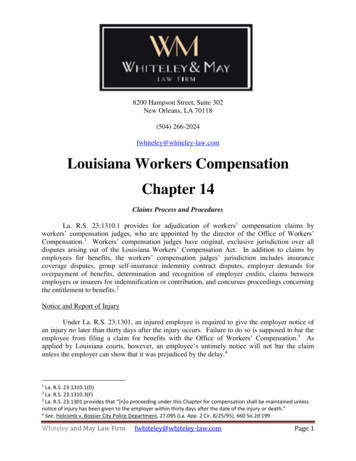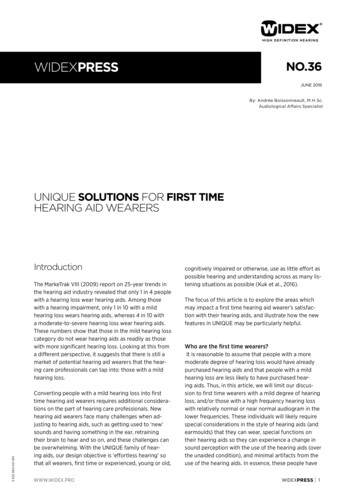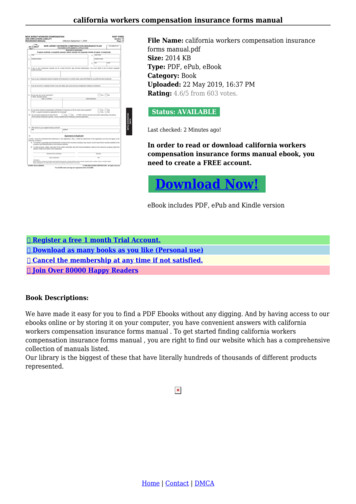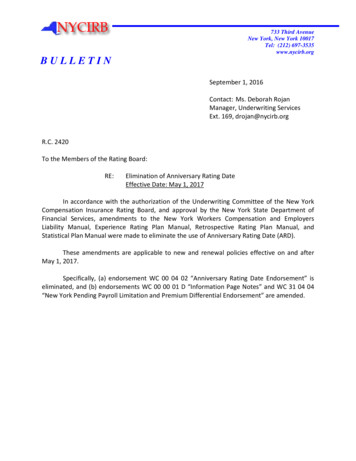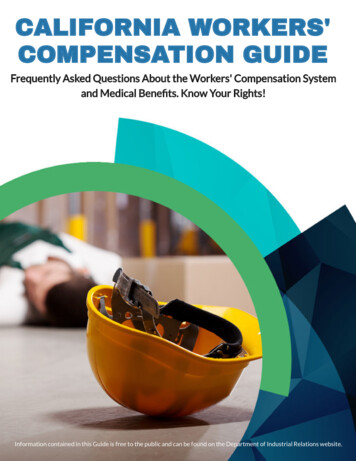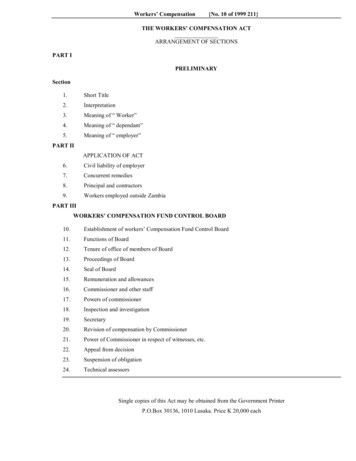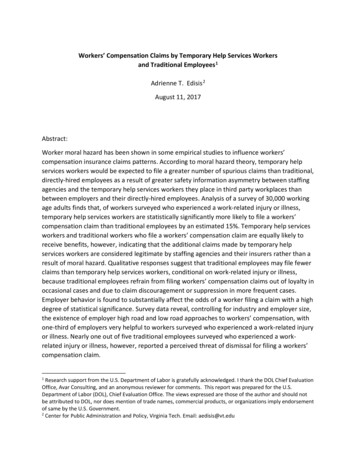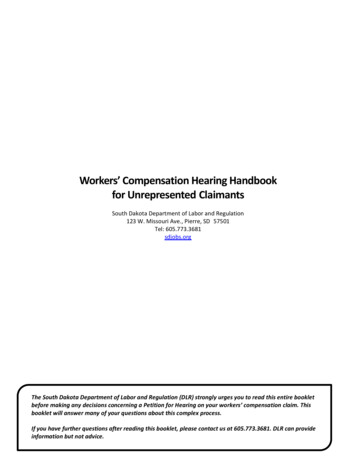
Transcription
Workers’ Compensation Hearing Handbookfor Unrepresented ClaimantsSouth Dakota Department of Labor and Regulation123 W. Missouri Ave., Pierre, SD 57501Tel: 605.773.3681sdjobs.orgThe South Dakota Department of Labor and Regulation (DLR) strongly urges you to read this entire bookletbefore making any decisions concerning a Petition for Hearing on your workers’ compensation claim. Thisbooklet will answer many of your questions about this complex process.If you have further questions after reading this booklet, please contact us at 605.773.3681. DLR can provideinformation but not advice.
TABLE OF CONTENTSThe Decision to Hire a Lawyer . 1Coverage . 1Alternative Action . 1Small Claims Hearing .1Mediation .2The Hearing Process. 2The Petition for Hearing.2The Answer . 3Discovery and Pre-hearing Procedures . 3Depositions .4Subpoenas .4Interrogatories .4Demand for Production .4Request for Admission.4Mental or Physical Examination .4Medical Records .5Motion to Compel .5Scheduling Orders .5The Hearing . 5Five Tips for Representing Yourself at a Hearing . 7Assistance from DLR Staff . 7Glossary of Legal Terms . 8Forms Library. 9
If you and an employer, claim administrator or insurance company (referred to as the “Employer/Insurer”) cannot agreeon the amount of workers’ compensation benefit that should be paid, either you or the Employer/Insurer may petitionthe South Dakota Department of Labor and Regulation (DLR) for a hearing. This handbook is intended to answer generalquestions about the hearing process. Terms in italics are defined in the Glossary of Legal Terms (Page 8).THE DECISION TO HIRE A LAWYERMany individuals hire a lawyer to take their workers’ compensation case to DLR because the issues can be complicated.The state does not provide an attorney for you. The Employer/Insurer will be represented by an attorney and individualscan be at a disadvantage if they are unrepresented. Not all attorneys handle employee workers’ compensation issues, sobe sure to ask potential attorneys about workers’ compensation. Representation must be handled by a licensedattorney. You do not have to have an attorney to file a petition, but it is strongly encouraged.If an attorney is hired, the maximum fee the attorney can collect is limited by state law. The percentage is based on bothmedical benefits and disability benefits the employer would not have paid unless the attorney got involved. Added tothe appropriate fee are the attorney’s costs, which include postage, phone use, fees for hiring experts, copying costs,etc. and sales tax.If an attorney is not hired or cannot be found, this handbook is designed to help handle your case and save you timeand headaches. This handbook offers information designed to help you learn about the process step by step. However,this handbook is only meant as a guide and does not offer legal advice. If you have questions regarding this information,please refer to the DLR website at sdjobs.org or call the Division of Labor and Management at 605.773.3681.State Bar of South DakotaLawyer Referral Help Line 1-800-952-2333 or visit sdbar.org for more information.Access to Justice, Inc. provides free legal assistance to eligible clients and coordinates attorneys who providepro bono legal services. Clients are responsible for paying case costs.To obtain information, email access.to.justice@sdbar.net or call 1.855.287.3510Or online at statebarofsouthdakota.com/page/access-to-justice for more information.COVERAGEThe state does not provide workers’ compensation coverage (except for state government employees). Othergovernment agencies are usually self-insured. If you work for the federal government, contact the U.S DOL Office ofWorkers’ Compensation Programs for more information.The Employer probably has a workers’ compensation insurance policy from a private insurance company. Privateemployers can be self-insured if certified by DLR. DLR has the power to hold hearings with insured or self-insuredemployers, but not uninsured employers. DLR can tell you if the Employer/Insurer is insured or self-insured. If theEmployer/Insurer is uninsured, and refuses to pay benefits, you will have to sue in Circuit Court for benefits you feel youshould receive.ALTERNATIVE ACTIONSmall Claims HearingA Small Claims Hearing is a less formal and much faster option than the standard hearing process. Petitions for aSmall Claims Hearing are allowed if: Your claim is 8,000 or less; Your claim involves medical costs only (no disability claims); and You have reached an agreement with the Employer/Insurer (and approved by DLR) that establishes your1
general right to workers’ compensation benefits, or DLR has issued an order establishing that right.A form to ask or to petition for a Small Claims Hearing is available in Sample 1 in the Appendix (or print a copyonline at dlr.sd.gov/workers df).The Small Claims Hearing rules are found in the Administrative Rules of South Dakota (ARSD 47:03:01:18 to47:03:01:28). These rules may be found online at sdlegislature.gov/Rules/RulesList.aspx. The rules allow ahearing to be held soon after the petition is filed. The Petitioner (the person who filed the petition) must provetheir case with evidence and testimony. Both the Petitioner and Respondent must appear at the hearing andpresent their case.If the requirements for Small Claims action are not met, you may file a regular Petition for Hearing.MediationIf the Employer/Insurer disputes your benefit claims, you may be able to negotiate a settlement. DLR canappoint a mediator to facilitate settlement discussions (mediation) if you and the Employer/Insurer agree. This isa simple, effective, no-cost alternative to the traditional hearing process. In a hearing, however, theadministrative judge may reach totally different conclusions about the merits of any claims.Most mediations are done by telephone, but the mediator can see the parties in person if they deem itnecessary. The DLR mediator is someone with experience in workers’ compensation law and procedure who willoffer opinions about the strengths and weaknesses of the parties’ legal positions. The parties are not bound togo along with the mediator’s positions. They can accept, reject or modify what the mediator recommends.You may use the Mediation Request From in Sample 2 of the Appendix in this booklet (or print a copy online onRequestForm.pdf) to request DLR to mediate. The form isonly required if you are requesting DLR to mediate. You may also mediate with non-DLR mediators, however,you or the Employer/Insurer will have to pay a non-DLR mediator for their services.THE HEARING PROCESSThe Petition for HearingYou may file a Petition for Hearing with DLR. Filing a petition means you are suing the Employer/Insurer. DLR does notcharge a fee for filing a petition for hearing. Similar to a Small Claims hearing, you, as the Petitioner, must prove yourcase. The Petition for Hearing (or Small Claims Petition for Hearing) must be filed two years from the date the denialletter was received from the insurance company. DLR accepts petitions for hearing by mail using the Petition forHearing in Appendix Sample 3 (or print online at df). You may useanother petition for hearing, but DLR requires the petition to include the following information: Your name Employer’s name Insurer’s name (if there is one) Time and place of accident Manner in which the accident occurred The fact that the employer had actual knowledge of the injury within three business days or thatwritten notice of injury was given to the employer Nature and extent of your disabilityAfter DLR receives the Petition for Hearing, DLR will send you and the Employer/Insurer an acknowledgment letterinforming the parties about the petition DLR received. It also instructs the Employer/Insurer to file a response to youand DLR within 30 days of the date on the letter. You will get a copy of the acknowledgment letter for your information;the form for the letter is included as Appendix Sample 4.Within a few weeks after the Petition for Hearing is filed, a DLR administrative judge is assigned to your case. When2
communicating with the judge: Never try to talk to the judge about your case without the Employer/Insurer being able to participate. Never write or email the judge about your case unless you send a copy to the Employer/Insurer at the sametime you send it to the judge. If you had contact with the judge about your case before the Petition for Hearing was filed, the judge may notbe able to hear your case. Tell DLR and the Employer/Insurer about the contact. A different judge may have tobe assigned. If you send documents to the judge, always send copies to the Employer/Insurer. If you reach a partial or complete settlement with the Employer/Insurer, DLR has to approve the settlement forit to be binding. Written communications should be readable without difficulty. Handwritten notes may be difficult to read, sotype (or have someone type for you) if possible.THE ANSWERAfter you file your petition, the Employer/Insurer is required to answer the petition, by admitting or denying eachstatement in the petition. If the Employer/Insurer does not respond with an answer within 30 days of the date of theacknowledgment letter, let DLR know that no answer has been received. In almost all cases, a telephone call or letterfrom us will get the required response. If, however, the Employer/Insurer continues to be unresponsive, you may askDLR to take further action on your behalf.When DLR has received the Answer, you and the Employer/Insurer will receive an Acknowledgement of Answer letter(example in Appendix Sample 5).DLR will not schedule a hearing or take other action unless you or the Employer/Insurer requests. Exchange as muchinformation with the Employer/Insurer, in particular medical records, as you can without using formal legal requests.Most of the time, the parties request information from each other as formal discovery requests. DLR does not needcopies of any of the information you receive until you are requesting formal action related to the document(s).The Acknowledgement of Answer letter will also identify the administrative judge assigned to the case. The judge can beremoved if you choose, but this action must be taken within 20 days of the letter. To remove a judge after the 20 days,you must show legally sufficient cause.In some cases, the Employer/Insurer will file a Petition for Hearing and DLR will instruct you to file an Answer to theEmployer/Insurer’s claims within 30 days. There is no form for the Answer but DLR requires the Answer letter to becomplete and “state clearly and concisely an admission or denial as to each allegation contained in the petition forhearing.” If the Employer/Insurer makes an assertion in its petition and you do not deny the assertion, the assertion maybe considered admitted by you.DISCOVERY AND PRE-HEARING PROCEDURESAfter DLR receives an Answer, most cases require a period of discovery and pre-hearing procedure before the case isready for hearing. DLR will not schedule a hearing until the parties let us know they are ready and the DLR judgeassigned to the case is comfortable the case is ready to be heard.Discovery is done by the parties before a hearing to collect information about the case. The goal of discovery is to helpthe parties go to the hearing with as much knowledge of the facts connected with the claim as possible. Parties areallowed to collect information that may never be revealed in the hearing, but the information requested must be likelyto help in finding hearing evidence. The discovery process includes depositions, interrogatories, demands for productionof documents, requests for admissions, requests for physical or mental examinations, as well as any motions used toenforce discovery rights.3
DepositionsA deposition is testimony taken under oath, but not during the hearing and not in the presence of the judge. A privatecourt reporter will be there to prepare a record of whatever is said. This record is called a transcript. DLR will not pay forproduction of a written transcript. That responsibility will belong to you and/or the Employer/Insurer.The deposition may be by written questions but is most often face-to-face. If you are deposed, you will be askedquestions about the claim or questions that might lead to the discovery of evidence about the claim. You can object tothe questions but will have to have a legally sufficient reason not to answer.When you are being deposed, you are under oath. You should be careful and accurate when answering questions at adeposition. If you answer a question, you will be assumed to understand it. If you do not understand or do not know theanswer, say so.Depositions are taken for several reasons. Sometimes witnesses will not be available for the hearing, and their testimonyneeds to be preserved. More commonly, people are gathering information and getting the witness’s version of events.They want to see for themselves how believable or credible the witness appears to be, because a judge will be decidingthat later. Witnesses can be “impeached” by their deposition testimony. For example, if witnesses admit in a depositionthat they did not speak to the boss about the injury, then testified at hearing that they did tell the boss, the depositiontestimony could be offered at the hearing to prove they were lying.SubpoenasWhen you are notified that you will be deposed, a subpoena or a subpoena duces tecum often comes with it. Asubpoena is an order, issued by DLR or an attorney invoking DLR’s powers, telling you to be in a certain place at aparticular time and day. A subpoena duces tecum orders you to turn over certain documents or to bring them to adesignated place at a particular time and day. If you cannot appear when scheduled, or cannot produce the subpoenaeddocuments, you should inform the other party. A subpoena or subpoena duces tecum is usually delivered to you (servedupon you) by a law enforcement officer, though they can be served by anyone. In some cases, you may receive anAdmission of Service with the subpoena by mail instead of having them personally served on you. This saves the sendermoney and time, but you do not have to sign and return the Admission of Service to the sender unless you want to.InterrogatoriesThese are written questions. When you respond to an interrogatory, you are swearing under oath to the answers. Eachquestion must be answered or objected to. If you do not know the answer, you are required to make reasonable effortsto find it. You should provide all answers no later than 30 days after the interrogatory is received. If that cannot be done,you should tell the party who sent it and ask for more time. If you have the answer later, or your answer changes withtime, you must send an updated answer to the Employer/Insurer. Appendix Sample 6 is a sample from an interrogatory.Demand for ProductionIf records, reports, email messages, or the like are needed, demands for production of documents are often made. Likeinterrogatories, you must comply with or object to the production demand. A business can assert that a productiondemand is too burdensome, and in some cases may comply by saying where its records are located so they can becopied, inspected or summarized. Appendix Sample 7 is a sample from a production demand.Request for AdmissionA request for admission is a request to a party to admit certain facts. One party sends the other a request for admissionso basic issues the parties agree upon can be resolved and not have to be proven if the parties go to hearing. The responseis to admit, deny or object to the request. If only part of the requested admission is true, admit to only that. AppendixSample 8 is a sample of an admission request.Mental or Physical ExaminationYou may be asked to attend a mental or physical examination. The rules about an examination depend on whether theexamination was ordered by a DLR judge. If you are not ordered to attend, the examination must be “reasonably4
convenient” for you. DLR has interpreted this to mean the trip must not worsen your condition or be under conditionswhich make it impracticable. The Employer/Insurer must pay the cost of you going to the examination, including thedoctor’s fees, meals, lodging and transportation. If the trip is reasonably convenient and you do not go, you will lose anydisability benefits you would have received, until you do attend an examination.If a party asks DLR to order you to attend an examination, the order must set out the time, place, manner, conditionsand scope of the examination, and the person or persons by whom it is to be made. You have the right to object to anyof these things.Once DLR orders you to attend, however, you must go.Medical RecordsMedical records, the examination notes or opinions from the medical provider, are a critical part of every workers’compensation case. However, a judge cannot consider them unless you do one or more of the following things:A. Show the records to the Employer/Insurer’s attorney, and have the attorney agree (stipulate) that the judge canconsider the records;B. Bring the medical provider to the hearing, and have them testify the records are theirs;C. Depose the medical provider and have them testify the records are theirs; ORD. Prepare an affidavit in which the provider says under oath and signed in the presence of a notary, that therecords are theirs. The affidavit needs to include the provider’s credentials. (Sometimes called a curriculumvitae, the credentials will look like a résumé). A sample affidavit can be found in Appendix Sample 9. TheEmployer/Insurer must be officially notified at least 30 days before the hearing that such an affidavit will beshown to the judge. Timely mailing of a Notice of Affidavit (Appendix Sample 10) will do that.Motion to CompelIf discovery laws are broken, DLR may intervene. For example, a party does not answer an interrogatory question,objects to it without proper grounds, or gives an evasive or incomplete answer. If the problem cannot be worked outbetween the parties, the affected party may file a Motion to Compel with DLR.This asks DLR to force a party to comply with discovery, and to reimburse the party for the costs (e.g. attorney’s fees) ofmaking the motion. If DLR grants the Motion to Compel and its order is not followed, DLR can take further action toenforce the order.Scheduling OrdersScheduling Orders set out a timeline for pre-hearing actions. You or the Employer/Insurer can make a written request tostart the process for such orders. DLR will send out a Proposed Scheduling Order (See Appendix Sample 11) asking youand the Employer/Insurer what deadline dates will work for both of you. Appendix Sample 12 is an example of aScheduling Order. You should look at it to get an idea of the deadlines such orders set. If the dates set in the order willnot work for you, contact the judge issuing the order to ask that they be changed.An important date in the Scheduling Order is the one for the Prehearing Conference. At that conference, the DLR judge,you and the Employer/Insurer will be on the telephone to discuss the hearing. You should be prepared to identify anywitnesses you plan to have at the hearing, to say what issues or claims you will have to present, and to tell the judgewhat days and times you have available to hold the hearing. A Prehearing Order (See Appendix Sample 13) is sent afterthe conference with a deadline for making schedule changes.You will also receive a Notice of Hearing (See Appendix Sample 14) to remind you where and when the hearing will beheld.THE HEARINGThe hearing is usually held in the community where the injury occurred. DLR will hold the hearing in as convenient alocation as possible. Hearings have been held in courtrooms, libraries, conference rooms, school offices and public5
meeting halls. The hearings are open to the public but are rarely attended by those without a direct interest in them. Acourt reporter hired by DLR will record the testimony. As in a deposition, no written transcript will be prepared unlessthe parties pay for it. DLR does not pay for this.The hearing rules are set by state administrative procedures and evidence law. The DLR judge is always a South Dakotalicensed attorney. The hearings are semi-formal and may last anywhere from an hour to several days. You and theEmployer/Insurer get to present your sides of the case and to question the witnesses that testify. All testimony is takenunder oath.You and the Employer/Insurer can testify, call witnesses and present other relevant evidence. After each witnesstestifies, the other side has the chance to ask questions or cross- examine the witness. After the first side has finishedpresenting all its evidence, the other side has the same opportunity to present its case through testimony and otherevidence. The judge may also ask the witnesses questions.Both sides must ask that documents be made part of the record. The other side will be given a chance to object to them.The judge decides whether the law allows you to include these documents in the record. At a minimum, documentshave to be authentic and relevant. For example, if the document is a letter from someone, you have to be able to proveit really is their letter (by evidence other than just the signature), and that the contents of the letter will help prove thefacts in your case. As with medical records, in some cases the Employer/Insurer may be willing to agree that documentsare authentic and/or relevant without more proof. You should talk to the Employer/Insurer about this before thehearing and see if they will stipulate.After both sides have had the chance to present all the information they wish, you will have the chance to giveconcluding remarks that summarize the facts and tell the judge what legal action you want the judge to take. Manytimes briefs are written instead of making oral comments; these briefs typically are done within a few weeks after thehearing.After the judge receives all the legal arguments the parties want to make, the judge will send out a Decision on the case.It is not a final decision at this point. The judge will instruct the parties to prepare Findings of Fact, Conclusions of Law,and an Order which, when signed by the judge, will make the Decision final. Appendix Sample 15 is an example ofFindings of Fact, Conclusions of Law and an Order.If you do not agree with the judge’s Decision and Findings, Conclusions and Order, you have the right to petition theSecretary of Labor to review them. The review must be requested no later than 10 days after the judge’s ruling becomesfinal. The Secretary may deny the petition, direct that an additional hearing be held or order that additional evidence bereceived.If you do not agree with the Secretary or wish to bypass review altogether, you have the right to appeal to Circuit Court,then to the state Supreme Court. It is beyond the scope of this handbook to explain the procedure for appealing a case.You are encouraged to talk to an attorney or review the laws about administrative appeals found in Chapter 1-26 of ourstate’s codified laws.6
FIVE TIPS FOR REPRESENTING YOURSELF AT A HEARING1Make a good impression.If you dress neatly, it tells the judge that you respect the process and care about your case.2Be respectful.Be respectful to everyone at the hearing, including the other side. Don’t argue with the judge. Tryto stay calm.3Make time for the hearing.Put aside sufficient time for this hearing. It may last all day or longer. You need to be there to presentyour case.4Prepare your case.Know in advance what witnesses you wish to question and the evidence you will need to haveadmitted, in order to prove your case. Bring at least three copies of any evidence you plan to use.Write out the questions you plan to ask and go over them with your witnesses before the hearing.5If you need help, consider hiring a lawyer.Most important, you can use a lawyer if you need help. You may start this case on your own, but laterrealize that you need the help of an attorney.ASSISTANCE FROM DLR STAFFDLR staff can give information but cannot give advice.DLR staff can give the following information: Has a petition (answer, motion, response, certificate of service, objection, etc.) been filed? I just got a petition for hearing. It says I have to file an answer. What is an answer? When does my answer haveto be filed? I just got a subpoena for a deposition. What does that mean? How can I get an interpreter for one of my witnesses? Who will pay for the interpreter? Can I subpoena a witness for hearing? What is a subpoena duces tecum? Can I get my medical records that were filed by the insurance carrier? Can I get information from a previous case? Where can I find an attorney? (State Bar of South Dakota Lawyer Referral Help Line, 800.952.2333)DLR staff cannot: Advise you whether to bring a petition to the Department. Give advice to one party but not the other party or take sides in a case. Advise you to take a particular course of action in your case. Disclose the outcome of a matter before it is public record. Give out information that must be kept confidential or is not public record. Give an opinion of what will happen if a petition is filed with the Department. Recommend a lawyer. Talk to the judge for you about your case. Let you talk to the judge without the other side being present.7
GLOSSARY OF LEGAL TERMSMedical records – notes or opinions from amedical provider following a medical exam, likelykept by the hospital or clinic. This does not usuallyinclude the medical bills.Notice of Hearing – an official notice from thejudge telling the parties when a hearing isscheduled.Petitioner – the person or company filing thepetition for hearing; similar to a “plaintiff” in acivil case.Pro Se – Latin for “in one’s own behalf”. A Pro Se(or Unrepresented) claimant is an individual whochooses to represent himself or herself in a legalproceeding without the aid of an attorney. TheDepartment cannot represent a Pro Se Claimant.Respondent – the person or company againstwhom the petition is brought; similar to a“defendant” in a civil case.SDCL – South Dakota Codified LawsService of process – a legal method of deliveringpapers to the opposing party in a lawsuit. Thisproves to the Department, by filing an affidavit ofservice or certificate of service, that the other sidereceived a copy of the papers.Settlement – an oral or written agreementbetween the parties regarding the matter beforethe Department. All settlements must be inwriting and approved by the Department beforeit
Workers' Compensation Hearing Handbook for Unrepresented Claimants South Dakota Department of Labor and Regulation 123 W. Missouri Ave., Pierre, SD 57501 . on the amount of workers' compensation benefit that should be paid, either you or the Employer/Insurer may petition the South Dakota Department of Labor and Regulation (DLR) for a .
